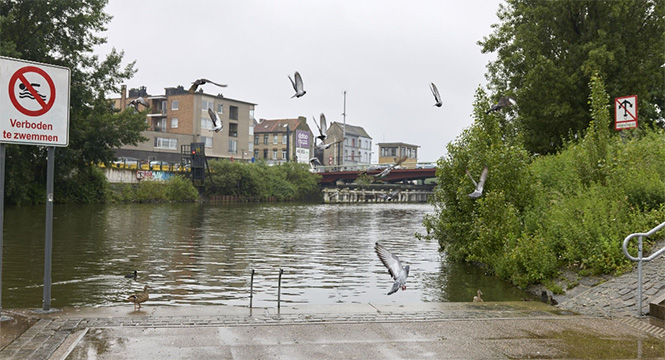 A "Forbidden to swim" sign at the Houtdok public park at the old dock in Ghent, Belgium.
A "Forbidden to swim" sign at the Houtdok public park at the old dock in Ghent, Belgium.
Photo: Bloomberg
It’s not just the Seine and the Thames. Across the continent, untreated waste that flows directly into rivers and lakes is making people sick and harming wildlife, Bloomberg writes.
Olympic triathletes had to contend with the same risk this summer in Paris, where they competed in the Seine after a €1.4 billion ($1.5 billion) effort to make the river swimmable for the first time in over a century. Poor water quality still forced organizers to postpone the big day and several athletes reportedly fell sick after their races.
The European Union this year updated three-decade-old rules for how countries must collect and treat their wastewater, but many are still failing to comply with older laws. The European Commission is currently taking legal action against Italy, Greece and Spain for not reaching clean water standards that should have been met years ago.
European nations also face a separate 2027 deadline to improve the health of their rivers, lakes and seas. The most recent update, in 2021, found that two-thirds of the continent’s surface water hasn’t improved enough.
“It's a lurking problem for many river cities and communities around the world,” says Mina Guli, a businesswoman who undertook a long-distance run along the Seine before the Olympics to raise awareness about river pollution. “What we are seeing now with the Seine and what we're seeing in the UK is a little bit of a canary in the coal mine.”
Sewage needs to be treated in several stages before it can be safely returned to the environment. The first filters out solids, the second removes harmful chemicals and reduces nutrients such as phosphorus and nitrogen which lead to harmful algae growth, and the steps after that disinfect the wastewater and remove more nutrients.
Some 20% of people in the EU live in places where only the first step occurs. An unknown amount of sewage is never treated at all — or only screened very cursorily — because it overflows from the sewers before it ever reaches a treatment plant.
That’s because European countries are very reliant on sewer systems known as Combined Sewer Overflows (CSOs), which act as a relief valve during heavy rain. The pipes channel excess rainwater, mixed with sewage, into open water bodies to prevent flooding or even water backing up into homes. Most of these systems were built in the 19th and 20th centuries.
How much waste ends up in open waters from CSOs depends on the size of collection and storage tanks, as well as how quickly the rainwater fills the sewers. Today, valves in Europe are often used far more than originally intended, in part because green spaces that would have absorbed rainwater have been paved over as cities developed.
Poor maintenance can also result in a build up of fats and oils, which causes sewage to spill over before the rain has a chance to sufficiently dilute it. In the worst cases, undiluted sewage is released when there's no rain, known as “dry day spilling.” A lack of monitoring across Europe makes it hard to know how often these dry spills occur. But data from the UK, which now monitors all of its CSOs after public backlash over spills, shows that they’re happening more frequently than previously thought.
But aging sewer and water treatment systems have long been overlooked as a problem. “Some countries don't even know where their CSOs are,” says David Butler, a professor of water engineering at the University of Exeter in the UK. The new EU regulations aim to change that, with a requirement for companies to monitor how often their systems spill.
As many as 90% of sewers in Poland are CSOs, among the highest levels in Europe.
The situation came to a head in 2022 when “several hundred kilograms of dead fish were fished out of the canal” every day, says Ewa Sternal, who owns a marina along the Gliwice Canal which connects to the Oder River. “[They] looked like they had been electrocuted.” The headlines were bad for business, says Sternal, who spent more than a decade helping to turn the former industrial site into a tourist attraction.
In Ghent, Belgium, homes used to eject their waste water directly into the canals; it’s still possible to see the pipes dotted along the walls. Some homes, especially outside the city, continue to do this. There are 8,000 CSOs in the wider region of Flanders that surrounds Ghent. As of last year, less than 10% were being monitored.
For residents who live by these waterways, it’s a shame to watch them contaminated by sewage. Freya Peeters, 43, runs a canal-side bar in Ghent. She’s been wary about swimming and kayaking in the river near her home after picking up E. coli from a river in Spain. And she’s seen dirty water from her neighbors' homes pouring directly into the river where she lives. A colleague once picked up a serious illness from swimming in the Ghent canal.
Cleaner water would help her attract more customers. “Where you can swim, it’s a place to meet,” she says. But, more importantly, the current situation just isn’t tenable, she says. “It’s not safe.”
read more in our Telegram-channel https://t.me/The_International_Affairs

 11:15 25.08.2024 •
11:15 25.08.2024 •






















